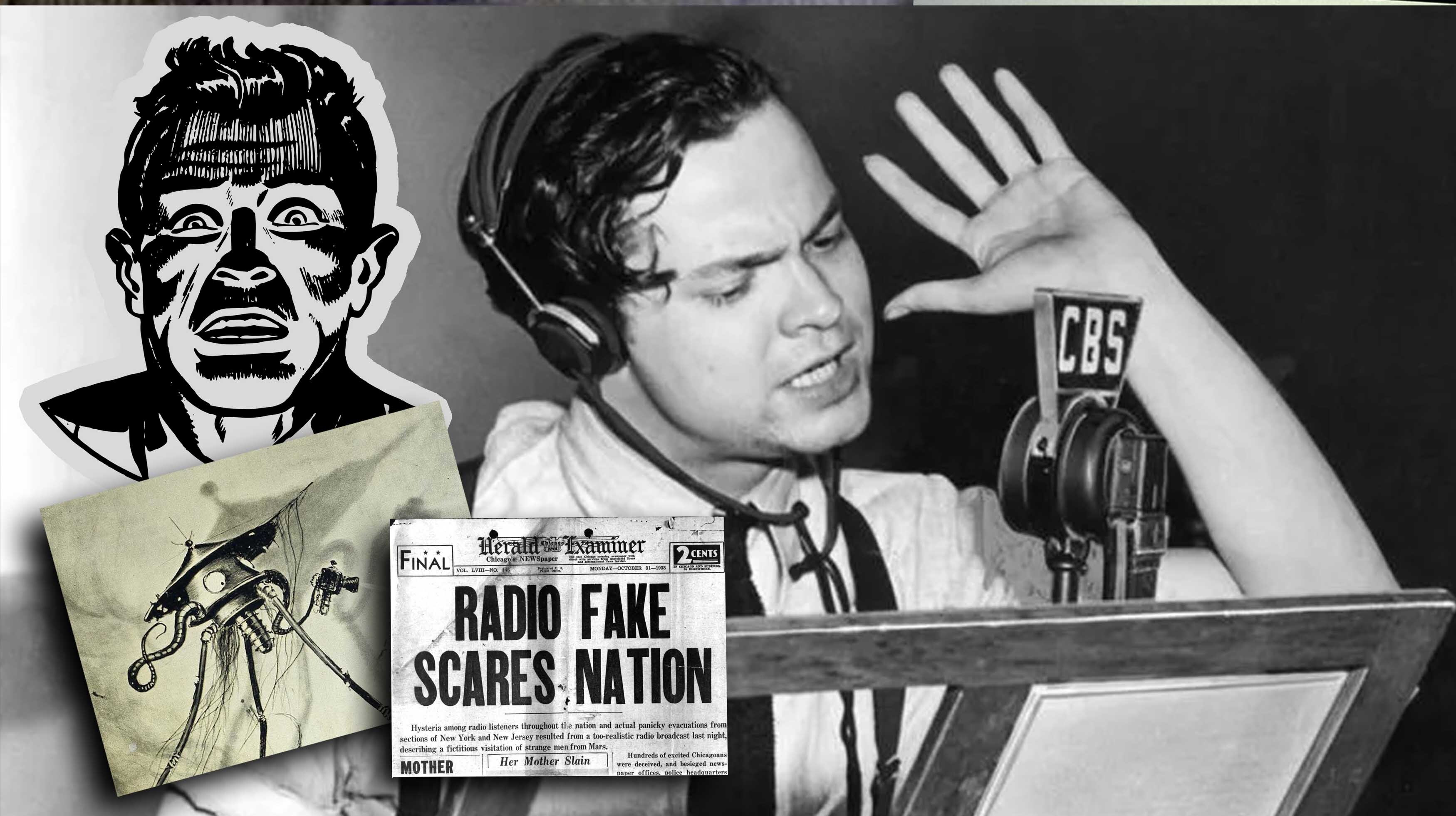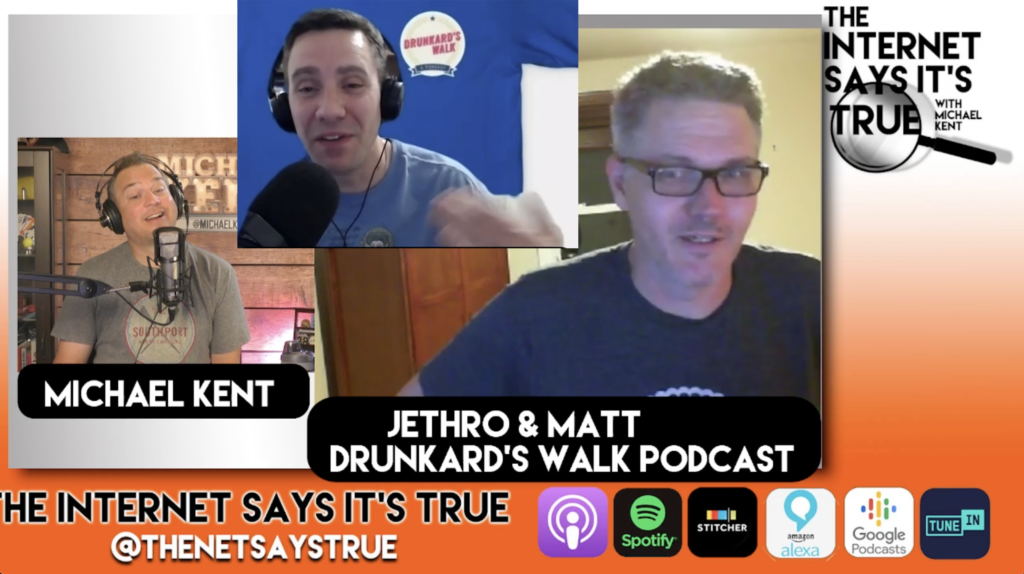Mass Hysteria and The War of the Worlds
Did a radio broadcast about Aliens cause mass Hysteria in America in 1938? The Internet Says…maybe. Orson Welles’s radio performance of H.G. Wells’s War of the Worlds has become infamous as causing panic throughout the U.S. when people thought it was a real news report. But is the story overblown? In this episode, we talk about the radio play and its reception. Then we play the quick quiz with Jethro and Matt from the Drunkard’s Walk Podcast!

It was the evening of October 30th, 1938 and Orson Welles had walked into the Columbia Broadcasting Building on Madison Avenue knowing it was going to be an interesting evening broadcast. He was scheduled to present the regular series “Mercury Theatre on the Air,” a weekly hour-long broadcast.
He had been inspired by a radio play he acted in the year before called “The Fall of the City.” It was a story about a conquerer that comes back from the dead to rule the city, but it was really an allegory on fascism. It made Orson Welles an overnight sensation in radio, and the style was something that was new. This new fad was taking hold that had been made popular by a radio program called “The March of Time”: the idea of telling a dramatized story as a live radio broadcast.
Welles experimented with the realistic-sounding radio broadcast storytelling format a couple more times the next year with an “As-it-happens” drama called “Air Raid” and a historical piece about Julius Caesar. But what he had planned for the Halloween Special was something bigger – something special and he knew it would be ground-breaking. He discussed the idea of adapting a piece of Sci-Fi for a radio broadcast with producers John Houseman and Paul Stewart and they decided on a 19th century piece of Sci-Fi set in England: H.G. Wells’s “The War of the Worlds.”
Howard Koch adapted the H.G. Wells work to a radio format for CBS by modernizing it. He took the setting from the original 19th century England to New Jersey in present day, choosing the tiny un-incorporated community of Grover’s Mill. The plot remained basically the same: Aliens from Mars invading Earth.
The dramatic piece began with a monologue similar to the novel.
From then, the radio play took the form of an “as-it-happens” news radio program, even playing music and interrupting that music with news bulletins, first reporting scientists have noticed unusual gas explosions on the planet Mars, then getting more serious.
The first two thirds of the program went on like this. To anyone who just tuned in, it would sound like a real news broadcast. There were weather reports and a supposed live broadcast of a musical performance from a local hotel: Ramon Raquello and his Orchestra. In fact, it was Welles’s intention to make these musical interludes last an uncomfortably long amount of time in order to add realism to the live broadcast style. A little bit after talking about the gas explosions on Mars, we hear about a strange meteorite landing.
The broadcast was so realistic, we even go on to hear screams and a moment of dead-air, something that was a huge no-no in the conventional rules of radio.
Eventually in the radio drama, the Martians are attacking and the broadcast focuses on the military units that are trying and failing. Then the broadcast turns to a supposed reporter on the roof of a building in Manhattan watching giant alien machines attack the city. The drama intensifies and then we hear the reporter become desperate.
There are a few moments of silence and then we get the first indication since the program began that this isn’t real. “You are listening to a CBS presentation of Orson Welles and the Mercury Theatre on the Air, in an original dramatization of The War of the Worlds by H. G. Wells. The performance will continue after a brief intermission. This is the Columbia Broadcasting System.”
There were only 4 instances throughout the entire broadcast to let listeners know it wasn’t real. The opening, before and after the middle commercial break, and at the very end. The commercial break itself was delayed 10 minutes later than usual to increase the realism of the piece. Later that night, three different times, disclaimers were read on the air to reiterate that the piece was merely fiction.
And the popular story about this broadcast – the reason anyone remembers it from the thousands of other radio plays in history – came about because of the many newspaper headlines that talked about it afterward. Headlines like “RADIO FAKE SCARES NATION,” “FAKE RADIO WAR STIRS TERROR THROUGH U.S.” and a lighted bulletin in Times Square reading “ORSON WELLES CAUSES PANIC.”
The broadcast had started at 8pm that night. By 8:32pm, the CBS Executive Davidson Taylor was on the phone taking a frantic phone call. Producer John Houseman said he returned to the studio “looking white as a ghost.” He had been ordered by the higher ups at CBS to immediately interrupt the broadcast to announce that it was a dramatic work of fiction. Luckily for Welles and Houseman, there was a scheduled commercial break less than a minute away. That commercial break carried disclaimers about the program before and after.
But as the show continued on, a few policemen entered the room outside the studio. Then a few more. CBS pages and executives stood in front of the police, begging them to just wait. The police wanted to barge into the studio and stop the broadcast immediately. They, of course, weren’t allowed into the room. The program continued.
The final third of the show was a more standard radio drama format without the realism of the news report break-ins and weather bulletins. We learn the rest of the story – that the Aliens have taken New York City and eventually have died of human pathogenic germs.
The broadcast ended with Orson Welles once again telling the listeners that they’ve been listening to a radio play and that it was merely a holiday offering for Halloween.
According to Houseman, the next few hours were crazy. Here’s a quote from his 1980 memoir: “The building was suddenly full of people and dark-blue uniforms. Hustled out of the studio, we were locked into a small back office on another floor. Here we sat incommunicado while network employees were busily collecting, destroying, or locking up all scripts and records of the broadcast.”
They apparently fielded a call from a small-town mayor who complained that his citizens were rioting in the streets.
One of the reasons that is often given for the panic is that people were listening to another program on the radio, and switched to The War of the Worlds after the opening disclaimer. Another reason for the panic that’s cited is that radio broadcasts for weeks had been updating America on the growing war between Germany and Czechoslovakia, so people were already on edge. They were used to hearing important news bulletins interrupting radio shows.
The newspaper headlines followed and the rest became a lasting legacy. Most people today know the story about how this radio broadcast sent Americans into a panic. But there are more than a couple reasons to doubt that it actually caused any sort of widespread panic. Robert Bartholomew, a sociologist who is an expert on mass panic outbreaks, has said that “there’s a growing consensus among sociologists that the extent of the panic was greatly exaggerated.”
First, there simply weren’t enough people listening. One of the pieces of evidence of panic is this treasure trove of 2,000 letters mailed to CBS and Orson Welles complaining about the broadcast. But when they were scrutinized, only about 27% of those letters came from people who were listening. It was originally reported that 12 million – or 1 out of 12 homes were listening to The War of the Worlds. But a survey was actually conducted that night during the broadcast. They had a sample size of only 5,000. But out of that 5,000, only 2% said they were listening to it. After all, it was up against the most popular radio show of the time, Edgar Bergen’s Chase and Sanborn Hour Variety Show. Mercury Theater on the Air had horrible ratings.
Another survey which was conducted later at Princeton estimated the real number listening was closer to 6 million. When those people were asked if they were “frightened or disturbed” by the show. 1.2 million said they were. But there’s sort of inherent problem with that question. In that era, radio had the power to move people. It had the ability to shock, to frighten and disturb. It would be like asking you about the scariest movie you’ve ever seen and ask if it frightened or disturbed you.
So this brings us to what is the most likely reason for the overblowing of the panic. Newspapers. Newspapers, whose existence was threatened by social media, and before that by online news, and before that by television news, were threatened by radio. It was in their best interest to get the public to have a healthy distrust of what they hear on the radio. So these many newspapers stories talking about the mass chaos and public panic caused by the broadcast could have had a motive, whether conscious or unconscious, of telling the public – “look at this new medium and take it with a grain of salt, because unlike a trusty newspaper, the radio can mislead the public!” Take the New York Times, for instance, who said “Radio is new but it has adult responsibilities. It has not mastered itself or the material it uses.”
So while the cultural lore about The War of the Worlds is one of groundbreaking realism and a story about not trusting everything you hear, the truth is probably a story that gives much more credit to the public at large. And proving that nothing is new under the sun, and proving history always repeats itself, the same thing happens today on Social Media. Celebrity death hoaxes are a weekly occurrence on Twitter. Fake News gets spread on Facebook by people who don’t take the time to find out whether or not it’s a true story. And certain news stations don’t cover major news events because of their own political interests. So in that way, what Orson Welles was doing really was groundbreaking. It was one of the first instances of nationwide trolling.

Review this podcast at https://podcasts.apple.com/us/podcast/the-internet-says-it-s-true/id1530853589
Bonus episodes and content available at http://Patreon.com/MichaelKent
For special discounts and links to our sponsors, visit http://theinternetsaysitstrue.com/deals
Listen to the Man Bites Dog Podcast here: https://www.manbitesdog.blog

